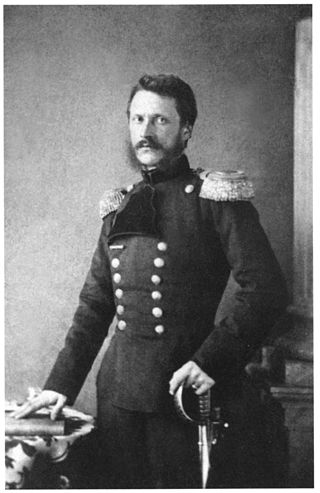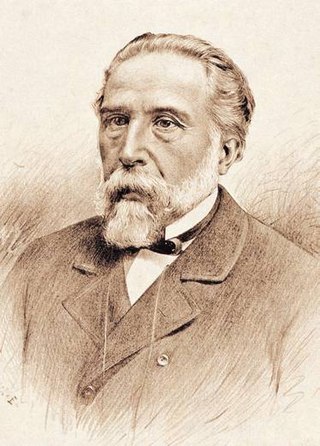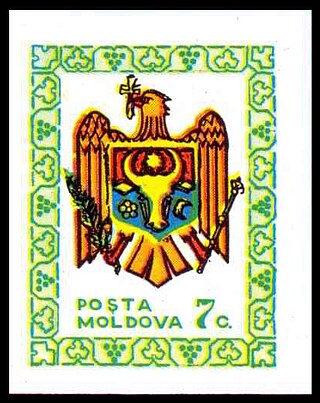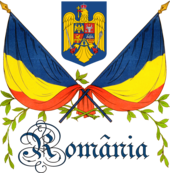
Alexandru Ioan Cuza was the first domnitor (Ruler) of the Romanian Principalities through his double election as prince of Moldavia on 5 January 1859 and prince of Wallachia on 24 January 1859, which resulted in the unification of the two states. He was a prominent figure of the Revolution of 1848 in Moldavia. Following his double election, he initiated a series of reforms that contributed to the modernization of Romanian society and of state structures.

Ion Ghica was a Romanian statesman, mathematician, diplomat and politician, who was Prime Minister of Romania five times. He was a full member of the Romanian Academy and its president many times. He was the older brother and associate of Pantazi Ghica, a prolific writer and politician.

Grigore Mihail Sturdza, first name also Grigorie or Grigori, last name also Sturza, Stourdza, Sturd̦a, and Stourza, was a Moldavian, later Romanian soldier, politician, and adventurer. He was the son of Prince Mihail Sturdza, a scion of ancient boyardom, and, during the 1840s, an heir apparent to the Moldavian throne, for which he was known throughout his later life as Moldavia's Beizadea. A rebellious youth famous for his feats of strength, he set up his own private militia which he used to corner the Moldavian grain trade, and entered a legal battle with Sardinian retailers. In 1845, he defied his father, and French law, by seeking to marry the much older, already married Countess Dash, and barricaded himself with her at Perieni. By 1847, Grigore had been reintegrated into the Moldavian establishment, and, as a general in the Moldavian princely militia, personally handled repression during the attempted revolution of April 1848. During these events, the Beizadea became personal enemies with three future statesmen—Alexandru Ioan Cuza, Mihail Kogălniceanu, and Manolache Costache Epureanu.

CN Poșta Română SA is the national operator in the field of postal services in Romania. It is the sole supplier of universal service in any point on the Romanian territory.

General Gheorghe Magheru was a Romanian revolutionary and soldier from Wallachia, and political ally of Nicolae Bălcescu.

Theodor Aman was a Romanian painter, engraver and art professor. He mostly produced genre and history scenes.

Dealul Mitropoliei, also called Dealul Patriarhiei, is a small hill in Bucharest, Romania and an important historic, cultural, architectural, religious and touristic point in the national capital. From a religious point of view, it is one of the centres of Romanian Orthodoxy: the headquarters of the Romanian Patriarchy and the residence of the Patriarch are both located here.
Freemasonry in Romania traces its origins to the 18th century. Following an intricate history, all organised Freemasonry in the country ceased during the Communist era, although some lodges continued to operate in exile overseas. Freemasonry returned to Romania in the 1990s.

Zimbrul şi Vulturul was a 19th-century Romanian newspaper, published in the city of Iași (Iassy), capital of the Principality of Moldavia, and having readership in other parts of what was to become the Kingdom of Romania.

The colors of the national flag of Romania has a long history, though the association of the three colors only dates to the 18th century. Red, yellow and blue were found on late 16th-century royal grants of Michael the Brave, as well as shields and banners. Thus, the late 13th century Wijnbergen armorial shows the coat of arms of the Wallachian ruler Litovoi as consisting of a shield of ten vertically alternating gold-and-red bands,. The same two colors, gules and or, also appeared on the late 15th century flag and coat of arms of Moldavia, during the reign of Stephen the Great. Then, from the late 16th century until the mid-17th century, the historical coat of arms of Transylvania gradually developed as a shield party per fess, consisting of a black eagle on blue background in the upper field, a dividing red band in the middle, and seven red towers on golden background in the lower field. Finally, in the last quarter of the 18th century, Bukovina gets its own coat of arms from the Habsburg Empire, a blue-and-red shield party per pale with a black aurochs' head in the middle, and three golden six-pointed stars surrounding it. During the Wallachian uprising of 1821, these three colors were present, along others, on the canvas of the revolutionaries' flag and its fringes; for the first time a meaning was attributed to them: "Liberty (blue-sky), Justice, Fraternity ( blood)".

The postal history of Monaco can be traced to the principality's first postmark in 1704. Stampless covers are known with both manuscript and handstamp postmarks for Monaco and Fort d'Hercule ; as the principality was once much larger, postmarks of the communes of Menton and Roquebrune prior to their 1848 secession might also be included. Monaco used Sardinian stamps from 1851 until 1860, when by the Treaty of Turin, Sardinia ceded to France the surrounding county of Nice and relinquished its protectorate over Monaco; French stamps with Monaco or Monte-Carlo postmarks were used thereafter. Two forms of cancellation are known for the French period. With the first, the postmark is on the cover away from the stamps; an obliterator with an identifying post office number 4222, or later 2387, inside a diamond of ink dots cancelled the actual stamps. The second applied the postmark directly on the stamps, as both a date stamp and cancel. All of these postal forerunners, particularly usages of Sardinian stamps with Monaco cancels, are far more valuable than the same stamps postally used in the issuing countries.

The postal history of San Marino can be traced to October 7, 1607, with the introduction of public postal services. The republic's postal needs were handled by a post office in nearby Rimini, Italy; the first San Marino post office opened in 1833.

The United Principalities of Moldavia and Wallachia, commonly called United Principalities or as Wallachia and Moldavia, was the personal union of the Principality of Moldavia and the Principality of Wallachia, formed on 5 February [O.S. 24 January] 1859 when Alexandru Ioan Cuza was elected as the Domnitor of both principalities, which were autonomous but still vassals of the Ottoman Empire and which resulted in the unification of both principalities. On 3 February [O.S. 22 January] 1862, Moldavia and Wallachia formally united to create the Romanian United Principalities, the core of the Romanian nation state.
This is a survey of the postage stamps and postal history of Bosnia and Herzegovina.

This is a survey of the postage stamps and postal history of Moldova.

Alexandru Papadopol-Calimah was a Moldavian-born Romanian historian, jurist, and journalist, who served as the Minister of Foreign Affairs and Minister of Culture of the Principality of Romania. As a maternal member of the Callimachi family, he had high aristocratic origins, but was a commoner on his father's side; he spent most of his life in the Moldavian town of Tecuci, whose history was a focus of his academic activity. He joined the Moldavian civil service in 1855, as a Spatharios in service to Prince Grigore Alexandru Ghica, and participated in applying Ghica's reforms. Papadopol-Calimah consequently discarded his Greek-and-Hellenized background to become an exponent of Romanian nationalism, supporting a political unification between Moldavia and Wallachia, which came about in 1859. He first served in the unified administration established by Domnitor Alexandru Ioan Cuza, rising from Prefect to State Council member, then to cabinet minister. Throughout his career, he remained closely aligned with Vasile Alecsandri and Mihail Kogălniceanu, and later also with Bogdan Petriceicu Hasdeu.
The Moldavian Bull's Heads are the first Romanian postage stamps, sold by Moldavia from July to October 1858. Released in four values, these stamps are renowned for their rarity. The second and third Romanian issues also feature the head of the aurochs, symbol of Moldavia—the former on its own and the latter, printed after the Union of the Principalities, alongside a representation of Wallachia.

Scarlat Vasile Vârnav, or Sofronie Vârnav, was a Moldavian and Romanian political figure, philanthropist, collector, and Orthodox clergyman. The scion of an aristocratic family, he was made to study for a career in the church, but fled Moldavia and studied abroad. Acquainted with the Romanian liberal movement, and an ardent Romanian nationalist, he helped establish bodies of intellectuals dedicated to cultural and political cooperation across the Danubian Principalities and beyond—including, in 1846, the Romanian library of Paris. His purchase of mainly Baroque paintings, donated by him to Academia Mihăileană, forms the core of the Iași Museum of Art.
The romanat or român was a proposed currency of the United Principalities of Moldavia and Wallachia, a precursor of the Romanian nation state. It was subdivided into 10 decimi or bani and 100 sutimi or bănișori.

The Vânători were a light infantry unit of the Romanian Army established on 1 July 1860. Compared to the regular infantry units, the Vânători specialized in close combat and high-precision firing on enemy positions, ambush actions, and had greater mobility on the field. In addition, the Vânători units also carried out protocol missions and guarded the royal and princely residences in Bucharest, Cotroceni, and Peleș, as well as the headquarters of the Ministry of War.





















